Related Research Articles
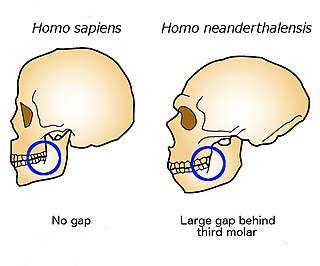
The retromolar space or retromolar gap is a space at the rear of the mandible, between the back of the last molar and the anterior edge of the ascending ramus where it crosses the alveolar margin.

Australopithecus africanus is an extinct species of australopithecine which lived between about 3.3 and 2.1 million years ago in the Late Pliocene to Early Pleistocene of South Africa. The species has been recovered from Taung, Sterkfontein, Makapansgat, and Gladysvale. The first specimen, the Taung child, was described by anatomist Raymond Dart in 1924, and was the first early hominin found. However, its closer relations to humans than to other apes would not become widely accepted until the middle of the century because most had believed humans evolved outside of Africa. It is unclear how A. africanus relates to other hominins, being variously placed as ancestral to Homo and Paranthropus, to just Paranthropus, or to just P. robustus. The specimen "Little Foot" is the most completely preserved early hominin, with 90% of the skeleton intact, and the oldest South African australopith. However, it is controversially suggested that it and similar specimens be split off into "A. prometheus".
The term bioarchaeology has been attributed to British archaeologist Grahame Clark who, in 1972, defined it as the study of animal and human bones from archaeological sites. Redefined in 1977 by Jane Buikstra, bioarchaeology in the United States now refers to the scientific study of human remains from archaeological sites, a discipline known in other countries as osteoarchaeology, osteology or palaeo-osteology. Compared to bioarchaeology, osteoarchaeology is the scientific study that solely focus on the human skeleton. The human skeleton is used to tell us about health, lifestyle, diet, mortality and physique of the past. Furthermore, palaeo-osteology is simple the study of ancient bones.
Sacrifice was a religious activity in Maya culture, involving the killing of humans or animals, or bloodletting by members of the community, in rituals superintended by priests. Sacrifice has been a feature of almost all pre-modern societies at some stage of their development and for broadly the same reason: to propitiate or fulfill a perceived obligation towards the gods.

The practice of human sacrifice in pre-Colombian cultures, in particular Mesoamerican and South American cultures, is well documented both in the archaeological records and in written sources. The exact ideologies behind child sacrifice in different pre-Colombian cultures are unknown but it is often thought to have been performed to placate certain gods.

The enthesis is the connective tissue between tendon or ligament and bone.

Actun Tunichil Muknal, also known locally as ATM, is a cave in Belize, near San Ignacio, Cayo District, notable as a Maya archaeological site that includes skeletons, ceramics, and stoneware. There are several areas with skeletal remains in the main chamber. The best known is "The Crystal Maiden", the skeleton of what is believed to be a 17-year-old boy, possibly a sacrifice victim, whose bones have been calcified to a sparkling, crystallized appearance.
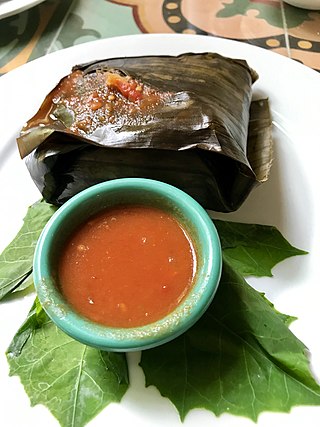
Ancient Maya cuisine was varied and extensive. Many different types of resources were consumed, including maritime, flora, and faunal material, and food was obtained or produced through strategies such as hunting, foraging, and large-scale agricultural production. Plant domestication concentrated upon several core foods, the most important of which was maize.
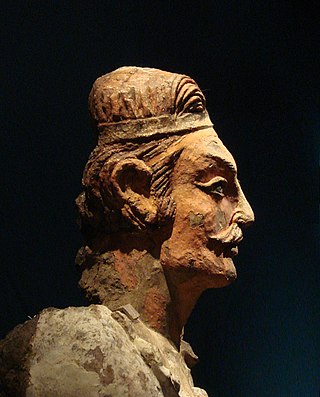
Artificial cranial deformation or modification, head flattening, or head binding is a form of body alteration in which the skull of a human being is deformed intentionally. It is done by distorting the normal growth of a child's skull by applying force. Flat shapes, elongated ones, rounded ones, and conical ones are among those chosen or valued in various cultures. Typically, the shape alteration is carried out on an infant, as the skull is most pliable at this time. In a typical case, headbinding begins approximately a month after birth and continues for about six months.
Dogs in Mesoamerica of various sorts are known to have existed in prehispanic times as shown by archaeological and iconographical sources, and the testimonies of the 16th-century Spaniards. In the Central Mexican area, there were three races: the medium-sized furred dog (itzcuintli), the medium-sized hairless dog (xoloitzcuintli), and the short-legged, (tlalchichi) based in Colima and now extinct. Apart from other, more obvious functions, dogs were also used for food and ritual sacrifice.

Mayan cave sites are associated with the Mayan civilization of pre-Columbian Mesoamerica. Beliefs and observances connected with these cave sites persist among some contemporary Mayan communities. Many of the Mayan caves served religious purposes. For this reason, the artifacts found there, alongside the epigraphic, iconographic, and ethnographic studies, help build the modern-day understanding of the Mayan religion and society.
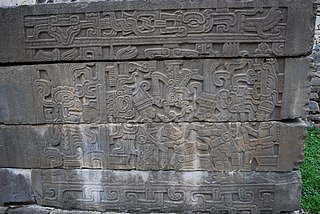
Most of the ancient civilizations of Mesoamerica such as the Olmec, Maya, Mixtec, Zapotec and Aztec cultures practiced some kind of taking of human trophies during warfare. Captives taken during war would often be taken to their captors' city-states where they would be ritually tortured and sacrificed. These practices are documented by a rich material of iconographic and archaeological evidence from across Mesoamerica.

The Wezmeh Cave is an archaeological site near Islamabad Gharb, western Iran, around 470 km (290 mi) southwest of the capital Tehran. The site was discovered in 1999 and excavated in 2001 by a team of Iranian archaeologists under the leadership of Dr. Kamyar Abdi. Wezmeh cave was re-excavated by a team under direction of Fereidoun Biglari in 2019.

During the pre-Columbian era, human sacrifice in Maya culture was the ritual offering of nourishment to the gods and goddesses. Blood was viewed as a potent source of nourishment for the Maya deities, and the sacrifice of a living creature was a powerful blood offering. By extension, the sacrifice of human life was the ultimate offering of blood to the gods, and the most important Maya rituals culminated in human sacrifice. Generally, only high-status prisoners of war were sacrificed, and lower status captives were used for labor.

Pacbitun is a Maya archaeological site located near the town of San Ignacio, Belize, in the Cayo District of west central Belize. The modern Maya name given to the site means “stone set in earth”, likely a reference to multiple fragments of stone monuments. The site, at about 240 m above sea level, is one of the earliest known from the southern Maya Lowlands, and was inhabited for almost 2000 years, from ca. 900 BCE to 900 CE. Strategically, it straddles a territory of rolling, hilly terrain between the Mountain Pine Ridge and the tropical forest covered lowlands of the Upper Belize River Valley.

Medieval Bioarchaeology is the study of human remains recovered from medieval archaeological sites. Bioarchaeology aims to understand populations through the analysis of human skeletal remains and this application of bioarchaeology specifically aims to understand medieval populations. There is an interest in the Medieval Period when it comes to bioarchaeology, because of how differently people lived back then as opposed to now, in regards to not only their everyday life, but during times of war and famine as well. The biology and behavior of those that lived in the Medieval Period can be analyzed by understanding their health and lifestyle choices.
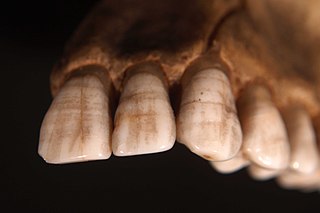
Linear enamel hypoplasia is a failure of the tooth enamel to develop correctly during growth, leaving bands of reduced enamel on a tooth surface. It is the most common type of enamel hypoplasia reported in clinical and archaeological samples, with other types including plane-form enamel hypoplasia and pitting enamel hypoplasia.

The Alepotrypa Cave is an archaeological site in the Mani region of the Peloponnese peninsula. In addition to being inhabited by early farmers, this site was used for burial and cult purposes. Archaeological evidence has revealed that this is one of the largest Neolithic burial sites ever found in Europe. Two adult human skeletons were found at the site from a burial dating to the 4th millennium BC, as well as remains from at least 170 separate persons. Archaeologists are uncertain about the significance of a Mycenaen ossuary, which has been dated to the 2nd millennium BC and appears to have been reburied at Alepotrypa. While there is no direct evidence, it is possible that the ossuary may link Alepotrypa to Tainaron, which was regarded as the entrance to Hades in classical mythology.
Sonia Ruth Zakrzewski is a bioarchaeologist and associate professor at the University of Southampton.
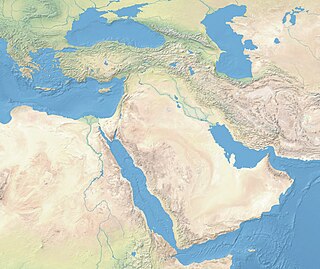
Near Eastern bioarchaeology covers the study of human skeletal remains from archaeological sites in Cyprus, Egypt, Levantine coast, Jordan, Turkey, Iran, Saudi Arabia, Qatar, Kuwait, Bahrain, United Arab Emirates, Oman, and Yemen.
References
- ↑ "Midnight Terror Cave". California State University, Los Angeles. 7 May 2015.
- 1 2 3 "Why this mysterious Mayan cave full of children's bones may be evidence of ancient human trafficking". Washington Post. 30 March 2015. Retrieved 26 April 2016.
- 1 2 3 Kieffer, C. L. (2017). "Sacrifice of the Social Outcasts: Two Cases of Klippel-Feil Syndrome at Midnight Terror Cave, Belize". International Journal of Osteoarchaeology. 27: 45–55. doi:10.1002/oa.2456.
- ↑ "The 'Midnight Terror Cave' of Belize was a child sacrifice site, experts report".
- ↑ Kieffer, C. L. "Determining Status of Ancient Maya from Looted and Sacrificial Contexts".
- ↑ Kieffer, C. L. "Preliminary Observations on the Investigation of Midnight Terror Cave".
- ↑ Prout, Michael G. (2016). "A Correction and Comment on Sacrifice of the Social Outcasts". International Journal of Osteoarchaeology. 26 (6): 1101-1102 (2016). doi:10.1002/oa.2487.
- ↑ Kieffer, C. L. (2016). "A rebuttal to Comments on Sacrifice of the Social Outsider". International Journal of Osteoarchaeology. 26 (6): 1099–1100. doi:10.1002/oa.2486.